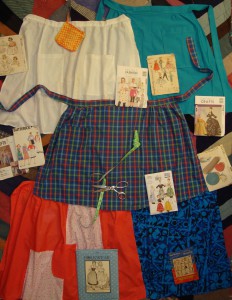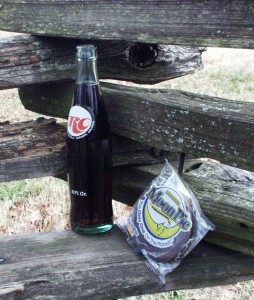By Karen
I write this as we move into what is, for many of us, the biggest gift giving season of the year. Some of us are approaching the season in “business as usual” mode, some are looking at gifts and consumption in a new minimalist light, while still others are economizing based on need to do so. But, all of us want the gifts that we give to be enjoyed and appreciated.
Everything I’ve done lately is marked by sentimentality and a sense of family. I’ve done a lot of looking back as Russ and I have been working to open our Six Degrees Store on Etsy. We’ve entirely rearranged the house, turning one bedroom into a studio, moving many things to the attic and making all of our spaces more artisan friendly. One thing I came across while turning my home upside down was a stack of my great grandmother’s aprons. We called her Grandma Pill. My mother gave her that name when she was a child because she took a lot of medication. Grandma Pill wore an apron every day, all day. It was part of her life’s uniform and she wasn’t dressed until she had it on.
When I was a child, I taught myself to sew making clothes for my dolls. One day my grandmother, we called her Mimi, got out the pattern to make her some new aprons for her mother. I decided that it was time to graduate from doll clothes to making gifts and I asked if I could sew Grandma Pill’s new aprons. Mimi granted my request, handed me the pattern and showed me some available fabric to choose from. The pattern was made of newspaper. It had evolved over time as Grandma Pill tweaked it now and then and it had been traced time and again as each new original became worn. It was plain, with just a little shape and two pockets.
I wanted my gift to be special. I pulled out some of the fancy patterns that I had my eye on out from underneath the large oak buffet and suggested that I might make one of them. Mimi said “Well, you can make one of those if you want to, but if you’re making an apron for mother, you need to use this pattern because this is what she wants.” I was disappointed. I was still in Barbie doll land, and Barbie is a fashion doll. Plain was not really what a little girl who was hoping to make something special really wanted to think about, but Mimi had a very certain tone in her voice and I wanted to make the apron, so I did what she told me to. I made a plain, ordinary everyday apron. It was hard to make my child’s yearning heart to handle plain, but it was exactly what Grandma Pill wanted, and it was special because her great granddaughter made it. She was delighted. I didn’t learn any significant new sewing skills that day, but I did learn a lot about giving.


